Guanxiong Shen
Physical Layer-Based Device Fingerprinting for Wireless Security: From Theory to Practice
Jun 11, 2025Abstract:The identification of the devices from which a message is received is part of security mechanisms to ensure authentication in wireless communications. Conventional authentication approaches are cryptography-based, which, however, are usually computationally expensive and not adequate in the Internet of Things (IoT), where devices tend to be low-cost and with limited resources. This paper provides a comprehensive survey of physical layer-based device fingerprinting, which is an emerging device authentication for wireless security. In particular, this article focuses on hardware impairment-based identity authentication and channel features-based authentication. They are passive techniques that are readily applicable to legacy IoT devices. Their intrinsic hardware and channel features, algorithm design methodologies, application scenarios, and key research questions are extensively reviewed here. The remaining research challenges are discussed, and future work is suggested that can further enhance the physical layer-based device fingerprinting.
Residual Channel Boosts Contrastive Learning for Radio Frequency Fingerprint Identification
Dec 12, 2024



Abstract:In order to address the issue of limited data samples for the deployment of pre-trained models in unseen environments, this paper proposes a residual channel-based data augmentation strategy for Radio Frequency Fingerprint Identification (RFFI), coupled with a lightweight SimSiam contrastive learning framework. By applying least square (LS) and minimum mean square error (MMSE) channel estimations followed by equalization, signals with different residual channel effects are generated. These residual channels enable the model to learn more effective representations. Then the pre-trained model is fine-tuned with 1% samples in a novel environment for RFFI. Experimental results demonstrate that our method significantly enhances both feature extraction ability and generalization while requiring fewer samples and less time, making it suitable for practical wireless security applications.
Towards Length-Versatile and Noise-Robust Radio Frequency Fingerprint Identification
Jul 06, 2022



Abstract:Radio frequency fingerprint identification (RFFI) can classify wireless devices by analyzing the signal distortions caused by the intrinsic hardware impairments. State-of-the-art neural networks have been adopted for RFFI. However, many neural networks, e.g., multilayer perceptron (MLP) and convolutional neural network (CNN), require fixed-size input data. In addition, many IoT devices work in low signal-to-noise ratio (SNR) scenarios but the RFFI performance in such scenarios is rarely investigated. In this paper, we analyze the reason why MLP- and CNN-based RFFI systems are constrained by the input size. To overcome this, we propose four neural networks that can process signals of variable lengths, namely flatten-free CNN, long short-term memory (LSTM) network, gated recurrent unit (GRU) network and transformer. We adopt data augmentation during training which can significantly improve the model's robustness to noise. We compare two augmentation schemes, namely offline and online augmentation. The results show the online one performs better. During the inference, a multi-packet inference approach is further leveraged to improve the classification accuracy in low SNR scenarios. We take LoRa as a case study and evaluate the system by classifying 10 commercial-off-the-shelf LoRa devices in various SNR conditions. The online augmentation can boost the low-SNR classification accuracy by up to 50% and the multi-packet inference approach can further increase the accuracy by over 20%.
Towards Receiver-Agnostic and Collaborative Radio Frequency Fingerprint Identification
Jul 06, 2022



Abstract:Radio frequency fingerprint identification (RFFI) is an emerging device authentication technique, which exploits the hardware characteristics of the RF front-end as device identifiers. RFFI is implemented in the wireless receiver and acts to extract the transmitter impairments and then perform classification. The receiver hardware impairments will actually interfere with the feature extraction process, but its effect and mitigation have not been comprehensively studied. In this paper, we propose a receiver-agnostic RFFI system that is not sensitive to the changes in receiver characteristics; it is implemented by employing adversarial training to learn the receiver-independent features. Moreover, when there are multiple receivers, this functionality can perform collaborative inference to enhance classification accuracy. Finally, we show how it is possible to leverage fine-tuning for further improvement with fewer collected signals. To validate the approach, we have conducted extensive experimental evaluation by applying the approach to a LoRaWAN case study involving ten LoRa devices and 20 software-defined radio (SDR) receivers. The results show that receiver-agnostic training enables the trained neural network to become robust to changes in receiver characteristics. The collaborative inference improves classification accuracy by up to 20% beyond a single-receiver RFFI system and fine-tuning can bring a 40% improvement for under-performing receivers.
FewSense, Towards a Scalable and Cross-Domain Wi-Fi Sensing System Using Few-Shot Learning
Mar 03, 2022
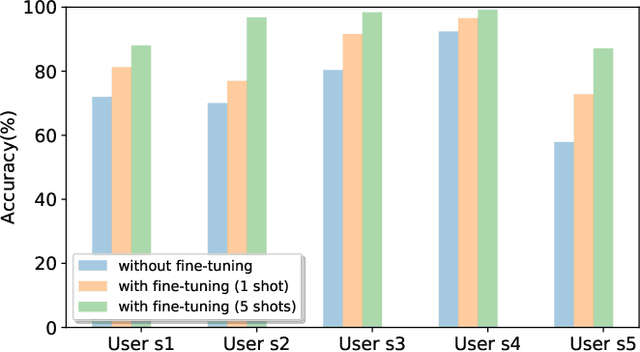
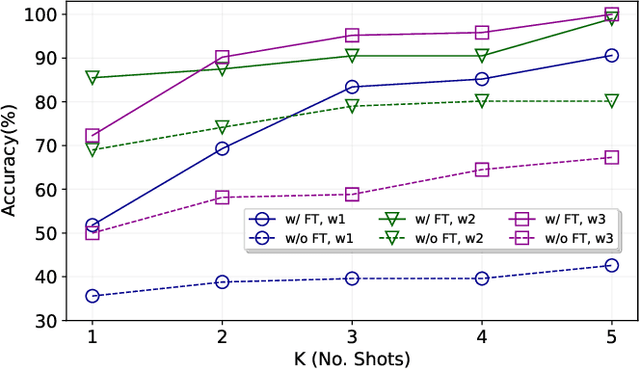

Abstract:Wi-Fi sensing can classify human activities because each activity causes unique changes to the channel state information (CSI). Existing WiFi sensing suffers from limited scalability as the system needs to be retrained whenever new activities are added, which cause overheads of data collection and retraining. Cross-domain sensing may fail because the mapping between activities and CSI variations is destroyed when a different environment or user (domain) is involved. This paper proposed a few-shot learning-based WiFi sensing system, named FewSense, which can recognise novel classes in unseen domains with only few samples. Specifically, a feature extractor was pre-trained offline using the source domain data. When the system was applied in the target domain, few samples were used to fine-tune the feature extractor for domain adaptation. Inference was made by computing the cosine similarity. FewSense can further boost the classification accuracy by collaboratively fusing inference from multiple receivers. We evaluated the performance using three public datasets, i.e., SignFi, Widar, and Wiar. The results show that FewSense with five-shot learning recognised novel classes in unseen domains with an accuracy of 90.3\%, 96.5\% ,82.7\% on SignFi, Widar, and Wiar datasets, respectively. Our collaborative sensing model improved system performance by an average of 30\%.
Radio Frequency Fingerprint Identification for Security in Low-Cost IoT Devices
Nov 28, 2021
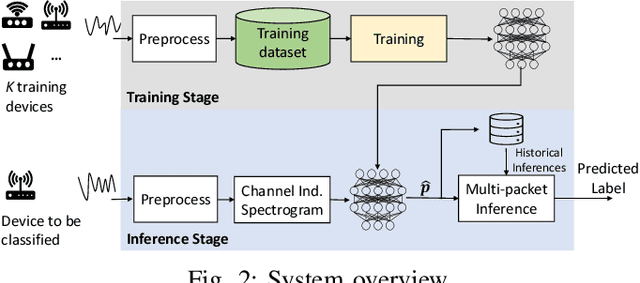
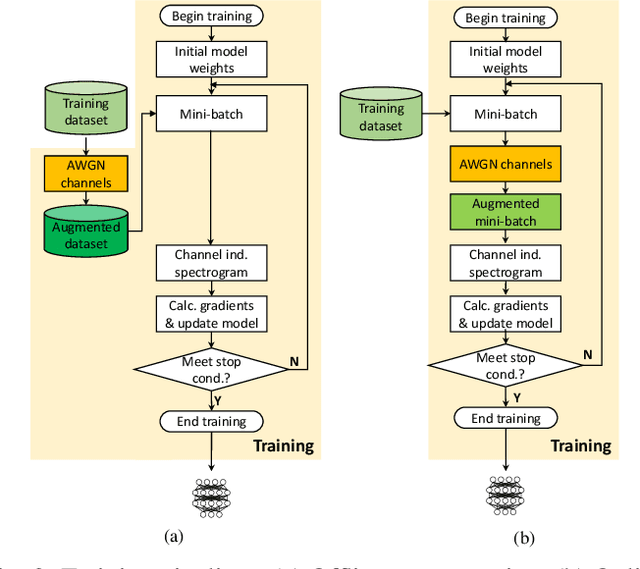
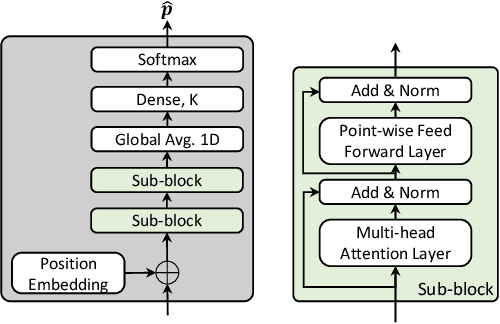
Abstract:Radio frequency fingerprint identification (RFFI) can uniquely classify wireless devices by analyzing the received signal distortions caused by the intrinsic hardware impairments. The state-of-the-art deep learning techniques such as convolutional neural network (CNN) have been adopted to classify IoT devices with high accuracy. However, deep learning-based RFFI requires input data of a fixed size. In addition, many IoT devices work in low signal-to-noise ratio (SNR) scenarios but the low SNR RFFI is rarely investigated. In this paper, the state-of-the-art transformer model is used as the classifier, which can process signals of variable length. Data augmentation is adopted to improve low SNR RFFI performance. A multi-packet inference approach is further proposed to improve the classification accuracy in low SNR scenarios. We take LoRa as a case study and evaluate the system by classifying 10 commercial-off-the-shelf LoRa devices in various SNR conditions. The online augmentation can boost the low SNR RFFI performance by up to 50% and multi-packet inference can further increase it by over 20%.
Towards Scalable and Channel-Robust Radio Frequency Fingerprint Identification for LoRa
Jul 06, 2021Abstract:Radio frequency fingerprint identification (RFFI) is a promising device authentication technique based on the transmitter hardware impairments. In this paper, we propose a scalable and robust RFFI framework achieved by deep learning powered radio frequency fingerprint (RFF) extractor. Specifically, we leverage the deep metric learning to train an RFF extractor, which has excellent generalization ability and can extract RFFs from previously unseen devices. Any devices can be enrolled via the pre-trained RFF extractor and the RFF database can be maintained efficiently for allowing devices to join and leave. Wireless channel impacts the RFF extraction and is tackled by exploiting channel independent feature and data augmentation. We carried out extensive experimental evaluation involving 60 commercial off-the-shelf LoRa devices and a USRP N210 software defined radio platform. The results have successfully demonstrated that our framework can achieve excellent generalization abilities for device classification and rogue device detection as well as effective channel mitigation.
Radio Frequency Fingerprint Identification for LoRa Using Spectrogram and CNN
Dec 30, 2020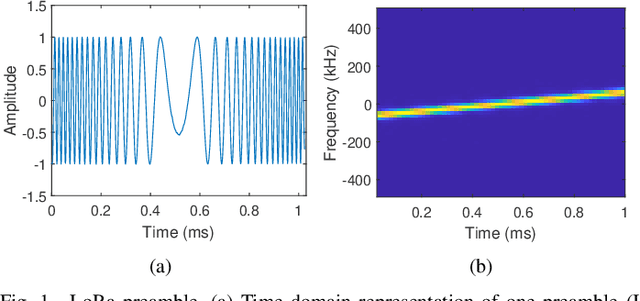
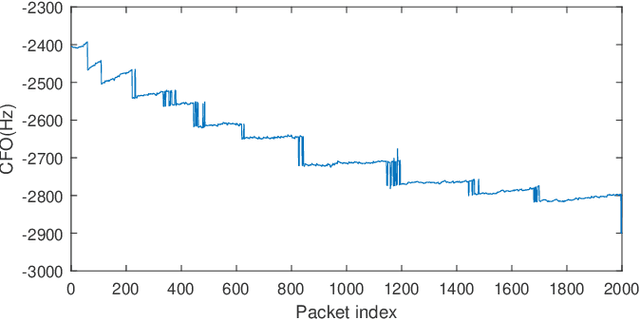
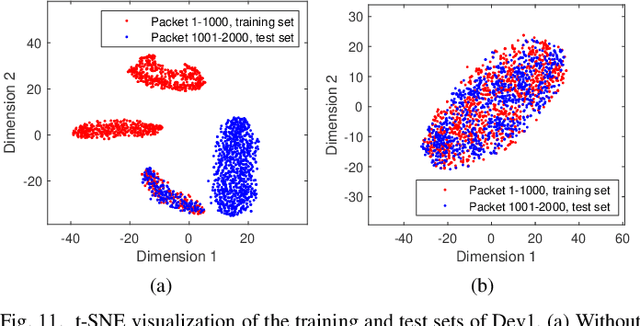
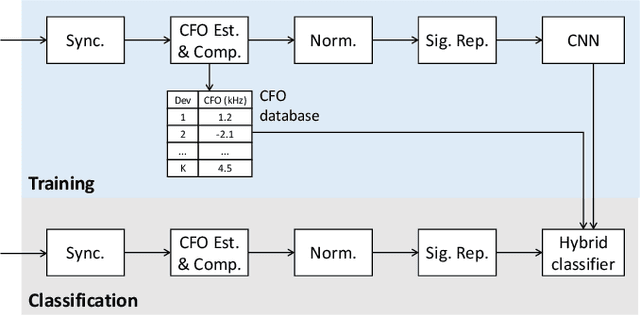
Abstract:Radio frequency fingerprint identification (RFFI) is an emerging device authentication technique that relies on intrinsic hardware characteristics of wireless devices. We designed an RFFI scheme for Long Range (LoRa) systems based on spectrogram and convolutional neural network (CNN). Specifically, we used spectrogram to represent the fine-grained time-frequency characteristics of LoRa signals. In addition, we revealed that the instantaneous carrier frequency offset (CFO) is drifting, which will result in misclassification and significantly compromise the system stability; we demonstrated CFO compensation is an effective mitigation. Finally, we designed a hybrid classifier that can adjust CNN outputs with the estimated CFO. The mean value of CFO remains relatively stable, hence it can be used to rule out CNN predictions whose estimated CFO falls out of the range. We performed experiments in real wireless environments using 20 LoRa devices under test (DUTs) and a Universal Software Radio Peripheral (USRP) N210 receiver. By comparing with the IQ-based and FFT-based RFFI schemes, our spectrogram-based scheme can reach the best classification accuracy, i.e., 97.61% for 20 LoRa DUTs.
 Add to Chrome
Add to Chrome Add to Firefox
Add to Firefox Add to Edge
Add to Edge